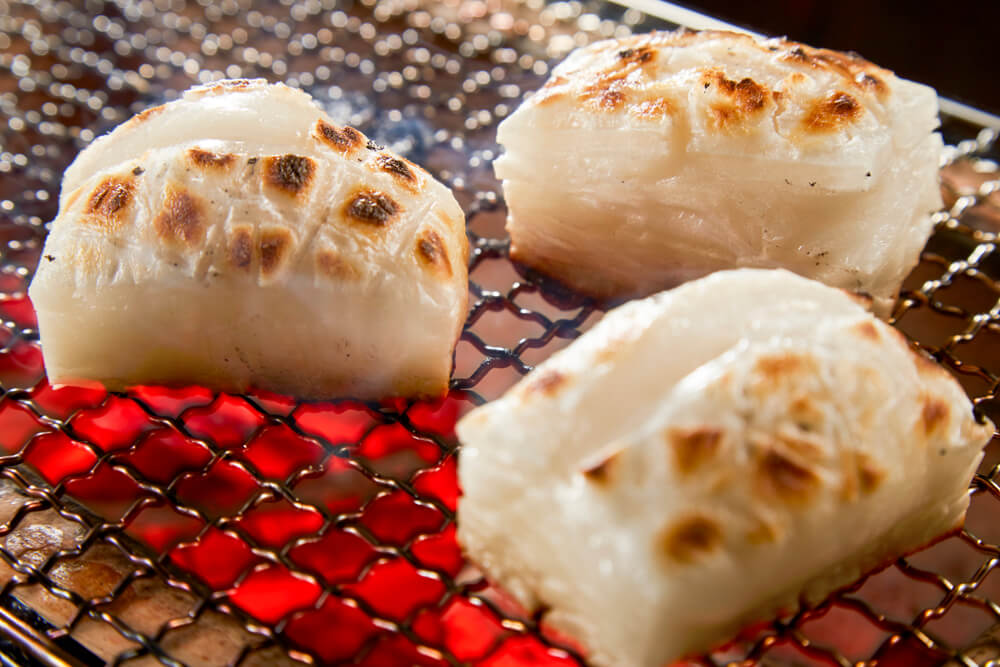Mochitsuki: The Traditional Art of Making Mochi
Dec 27, 2019
BY Nick Colaccino

I still remember the first mochi I ever had: the anko (red bean paste) softly glistening through the translucent mochi, and the coating of fine mochiko (rice flour) clinging to my fingers as I picked it up. Carefully I opened its beautiful plastic wrapping and took my first bite of heaven. The flavor had a richness and depth that far surpassed the sugary explosion of sweets that I was accustomed to, and the chewiness reminded me of incredibly soft, fresh taffy. I was in ecstasy… Which might be why my friend suggested we leave the convenience store.
I still enjoy conbini (convenience store) mochi, but I also see why my friend was embarrassed. Matcha is also one of the more popular flavors of mochi, since mochi is sweet and one of the tastes that pair best with matcha. I love grabbing matcha mochi from the conbini, but nothing beats the real thing. After living in a rural village for several years, I realized that while it may be delicious, convenience store mochi is devoid of the sweat, love, and comradery that has made the sweet famous. So, let’s take a look at the traditional art of making mochi, called mochitsuki.

While mochi is enjoyed year-round, it is particularly popular during the New Year’s holiday when families come together. This is important, because the traditional method of making mochi takes time and a lot of helping hands. The process begins the night before when the rice, mochigome, is cleaned and left to soak in water. Mochigome is glutinous (sticky) rice and is the sole ingredient of mochi (though spices and other flavoring can be added).
The next morning, the rice is steamed (heat allows for more water absorption) and then placed in a large mortar (usu) made of stone or wood. This is where the fun-but-back-breaking work begins! Using a wooden mallet (kine, pronounced “key-nay”), the rice is repeatedly pounded until it becomes a malleable mass of gelatinous rice goo (YUM!). In between each smash, the rice must be re-positioned and formed to ensure an even texture. As time is of the essence, rice pounding teams often form an elegant dance of near-finger-pulverizing misses. Youtube abounds with videos like “the world’s fastest mochi pounders.”
Once the rice has been thoroughly shown who’s boss, it is ready to be consumed. While you could just rip off a chunk and chow down, presentation is 9/10ths of the law in Japanese culinary culture. Usually, the rice is laid out on a table covered with mochiko (rice flour) and shaped. Mochi can take any form your heart desires, but it is generally shaped into a compact ball. Left to dry without refrigeration or preservatives, mochi will harden. People in ancient times believed that eating mochi after letting it harden throughout the New Year’s celebrations was good for your dental health.

Besides eating it plain, mochi is often added to ozoni, a traditional New Year’s soup dating back to the Muromachi Period. Ozoni usually goes hand-in-hand with osechi (which you can read more about here). Personally, while it’s all delicious, I just need the candied black beans from the osechi and a tub of ozoni to be a (fat and) happy boy on New Year’s Day.

Mochi can also be lightly roasted. After roasting, the mochi can be dipped into water and then coated with kinako, roasted soybean powder. Both the roasting and the kinako add an extra layer of richness and depth to the sweet.
Unfortunately, mass migration of the populous to urban centers makes it harder to gather the family for the holidays and devote the time and effort to making traditional mochi – a true shame, because taking your stress out on some rice would be great therapy for the rigors of modern urban life. Instead, most Japanese families either buy their mochi at the supermarket or use a mochi machine to speed the process up. That being said, if you happen to be in a rural area, it is still common to find families beating the daylights out of some rice around the holidays.
If you want to see or participate in mochi-pounding this year, your best bet would be to visit shrines, temples, or community centers. The next best thing is to find a local vendor selling freshly made mochi – I promise that it’ll be just as delicious!
Read more about New Year’s dishes HERE or check out our article on Sakuramochi HERE.
PIN THIS FOR LATER
In Tokyo for the New Year period? Be sure to join our Japanese New Year food tour in Shibuya!
Book your pocket wifi now to stay connected through your entire Japan Journey!

Be sure to get the JR Pass to make navigating Japan during your trip that much easier!

YOU MIGHT ALSO LIKE





